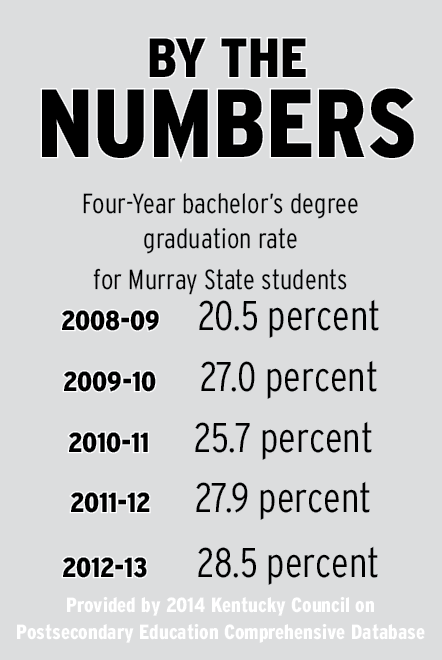Of the approximately 1,500 first-time freshmen beginning their fourth week of classes at Murray State this week, less than one third of them will graduate within four years.
Across the U.S., at both private and public universities, several students have taken an additional one or two years of college to graduate. According to a study performed by the Department of Education, more than 40 percent of students won’t complete their Bachelor’s degrees by their sixth year.
Aaron Troup, a fifth-year senior from Paducah, Ky., said he is predicted to graduate in the fall of 2016. He said he mostly has himself to blame for not graduating on time.
“A lot of it comes down to me,” Troup said. “I only took 12 credit hours per semester for the past two or three years and I had to drop a few classes from time to time because I didn’t keep up with the homework.”
Lowell Stevens, a fifth-year senior from Murray, said he contributes not graduating on time to a combination of indecisiveness, switching his major multiple times and poor academic advising.
“As a freshman, my advisers told me to take classes in my major early on so when I switched majors I lost a lot of hours,” Stevens said. “There are a lot of fantastic advisers at Murray State, but mine were kind of lazy and I was left on my own.”
A 2014 report by the Council on Postsecondary Education that followed a six-year cohort of students found that Murray State’s four-year graduation rate for 2013 was 28.5 percent, up 8 percent from 2009.
The University’s five-year graduation rate was reported as 47.6 percent and its six-year graduation rate was 53.2 percent.
Jay Morgan, vice president of Academic Affairs, said while a 53 percent graduation rate may seem low, compared to other public regional universities such as Eastern Kentucky University, Morehead State University and Kentucky State University, Murray State’s rate is well ahead.
Eastern Kentucky, Morehead State and Kentucky State boast six-year graduation rates of 39, 44 and 17 percent respectively.
Murray State’s Office of Retention reported that in the spring 2014 semester, of the 215 student withdrawals, the top reasons for not finishing college were for personal reasons, financial difficulty, family problems, health problems and work conflict.
Morgan said many of these issues, especially financial difficulty, work conflict and academic difficulties factor greatly into public universities’ graduation rates and are issues not typically faced by private institutions.
“We have a lot of students here who are on financial aid,” he said. “A lot of students either flunk out or who can’t afford to continue on. If you go and look at Vanderbilt, a top-tier school, their graduation rate will probably be closer to 90 percent because they’re attracting the best-of-the-best and those students don’t typically drop out.”
Morgan said the University is working on increasing its six-year graduation rate to 58 percent, a change which he said which may take the next eight years to accomplish.
One of the main tools of aiding students in graduating, either on time or at all, is the MAP-Works program, he said. Launched in the fall of 2012, the MAP-Works program is designed to help identify “at-risk students” quickly and provide them with support.
James Mantooth, director of the Office of Retention, said the program helps faculty and staff become more alert to students struggling academically, personally or financially, so they can receive the one-on-one attention they need.
“There is no ‘magic bullet’ for retention so it’s important that we strive to understand our students and what their individual factors are that influence their ability and desire to persist,” Mantooth said. “The success of our office is measured by whether or not our students persist from one semester to the next, and ultimately to graduation.”
Murray State is one of many Kentucky universities collaborating with the CPE’s “15 to Finish” campaign which launched last January.
The idea of the campaign pushes partnering colleges and their advisers to stress taking 15 credit hours of classes a semester or 30 hours in an academic year so students can graduate in four years.
Don Robertson, vice president of Student Affairs, said of the many resources available to students to help them graduate, including the Office of Retention and the Center of Academic Success, a help center for students with undeclared majors, the most important tool available to students is their adviser.
“If students utilize their adviser and do what they tell you to do, you should be able to graduate in four years,” Robertson said. “Sometimes students will ignore their adviser and not take the classes they need to or in the right sequence and miss the opportunity to take a class and get off track which ends up delaying their graduation.”
Helping students to graduate in four years shouldn’t be a university’s priority just because it will help their reputation and make them more attractive, but because it’s the right thing to do, Robertson said.
Story by Ben Manhanke,| Staff writer




























































































James M. La Valle • Sep 12, 2014 at 3:46 pm
Four year graduation rates of under 30% cannot be adequately explained by student matriculation error, major changes, student health problems, or course loads of under 15 credit hours. MSU administration knows full-well why graduation rates dropped to 20.5% back in 2009, and it was not because of any of the aforementioned reasons.